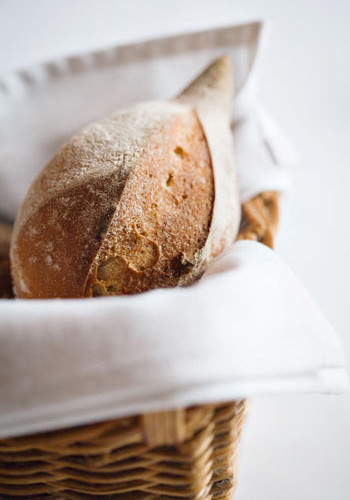Recipes
Sourdough rolls

The perfect sourdough recipe takes a bit of work, but you can count on Terroir’s Michael Broughton for the right technique. “Our ‘mother’ dough, which is affectionately named Sandy (and turns 9 in 2014), is treated the same as any member of staff,” says Michael. “She gets fed daily with a rich diet of fresh flour, water and beer.”
Serves: Serves 40 to 50
Ingredients
Method
TO MAKE THE STARTER DOUGH:
BEGIN BY MAKING A SEED CULTURE:
DAY 1
250 ml dark rye flour
125 ml organic apple juice
Mix together in a bowl and cover with plastic wrap. Leave at room temperature for 24 hours.
DAY 2
125 ml unbleached bread flour
60 ml organic apple juice
Add to the previous day’s mix and combine well. Cover with plastic wrap and leave at room temperature for 24 hours. It will have risen somewhat and start to smell pungent.
DAY 3
250 ml strong unbleached bread flour
125 ml water
Discard half the previous day’s dough and add the flour and water. Mix well, cover and leave at room temperature for 24 hours.
DAY 4
250 ml strong unbleached bread flour
190 ml water
Discard half the previous day’s dough. Add the water and mix well, then add
the flour and mix again. Cover and leave at room temperature for 12–24 hours – it should double in size. If not, leave for a few more hours. When fully risen, it should fall back when tapped. Now it can be turned into a starter dough.
TO MAKE THE STARTER DOUGH:
500 ml water
250 ml seed culture (see recipe above)
625 ml unbleached bread flour
To make the starter dough
Mix the water into the seed culture, and then beat in the flour until smooth.
Add another 125–250 ml water if the dough is too stiff. Leave in a cool, dry place covered with plastic for 4–6 hours until very bubbly and the plastic has swelled up from the gasses. Pop the plastic and re-cover. It is now ready for use in the bread recipe. Refrigerate overnight and feed (see below) within 24 hours.
TO FEED THE STARTER DOUGH:
There are various ways and methods of feeding the mother dough, but there is a general rule of thumb: replace what you use in the scale of one part (by weight) mother to the same weight of flour and water. So if you have 500 g starter dough left after using some, replace with 250 g flour and 250 g water.
We replace the water with beer every second day. It is important to keep your dough strong and clean-tasting by regular feeding every day or at least every second day. You can freeze it when you go away – refresh for about three days before you want to use it by feeding it every day using the above formula and ratio, and fermenting at room temperature.
TO MAKE THE ROLLS:
Mix all the ingredients, except the salt and starter dough, for 10 minutes on the no. 2 setting of an electric mixer fitted with a dough hook, adding a little more water if the dough is too stiff. Add the salt and continue on the same setting for another 5 minutes. Mix in the starter dough for 3 minutes. Place the dough in a large, lightly oiled bowl and leave to rest for 25 minutes.
Turn out onto a floured surface and spread the dough. Fold one-third of the dough onto itself, then repeat with the other side (like a letter fold). Fold in half lengthways. Turn it 90 degrees, spread out again by gently patting it with your hands, and repeat the fold. Rub some oil on some plastic wrap and cover the dough. Leave to rest for 30 minutes, then repeat the folding process twice more with a 30-minute interval between each fold. Be careful on the third turn not to push too hard and de-gas the dough too much. If the dough begins to blister and form little bubbles just beneath the surface, you’re on the right track. After the third fold, cover and rest the dough for a further 20 minutes to relax it.
Turn out onto a floured surface and shape into 40–50 ‘baguette’ shapes using a bread scraper. Place on a baking tray dusted with semolina. Place a medium-sized tray on the bottom of the oven while the rolls are proving and set the oven temperature to 250 °C. When the rolls have doubled in size, slash them down the centre with a bread lame or a razor blade and place them in the oven. Pour 190 ml cold water into the tray at the bottom of the oven and quickly close the door. Bake using the fan-assist setting for 8 minutes. (If you don’t have an oven with fan assist, add 3 minutes to the baking time.)
Open the oven quickly and turn the trays around, then bake for another 6–8 minutes or until a dark golden colour. Remove from the oven and cool on a wire rack.
Eat after 15 minutes or freeze if you like. Bake at 180 °C for 4 minutes from frozen.
Recipe extracted from Terroir: the cookbook, by Michael Broughton, published by Struik Lifestyle.










